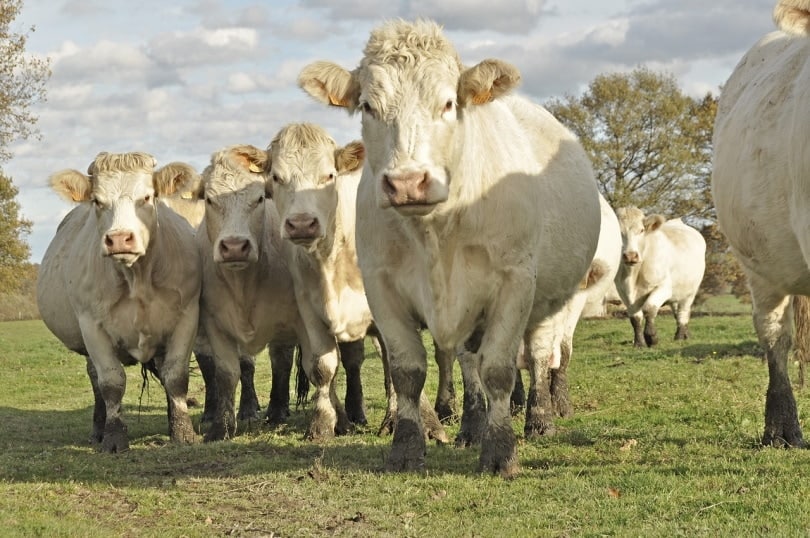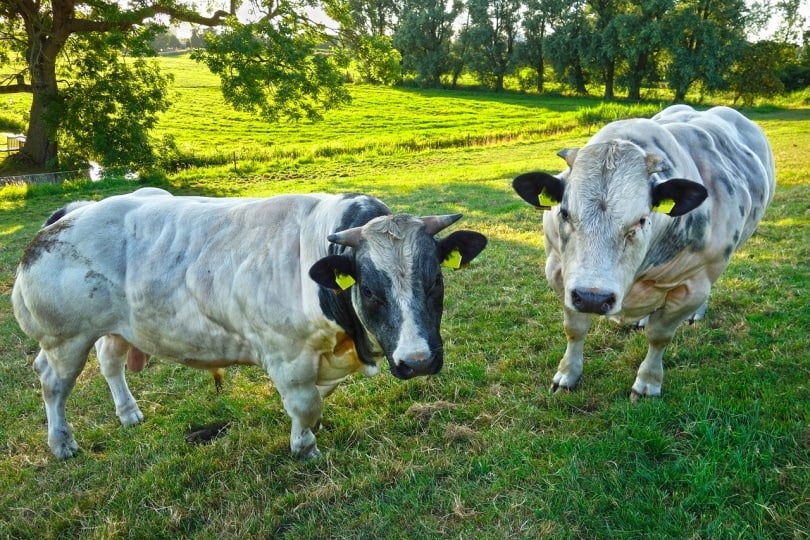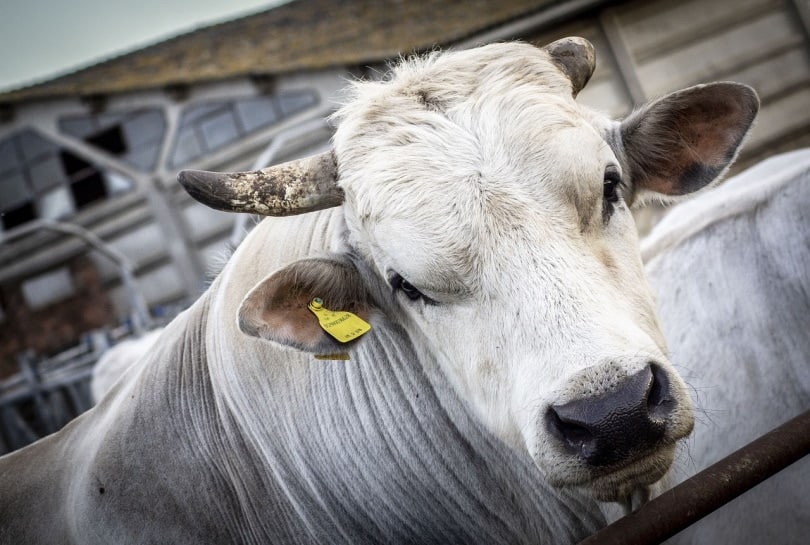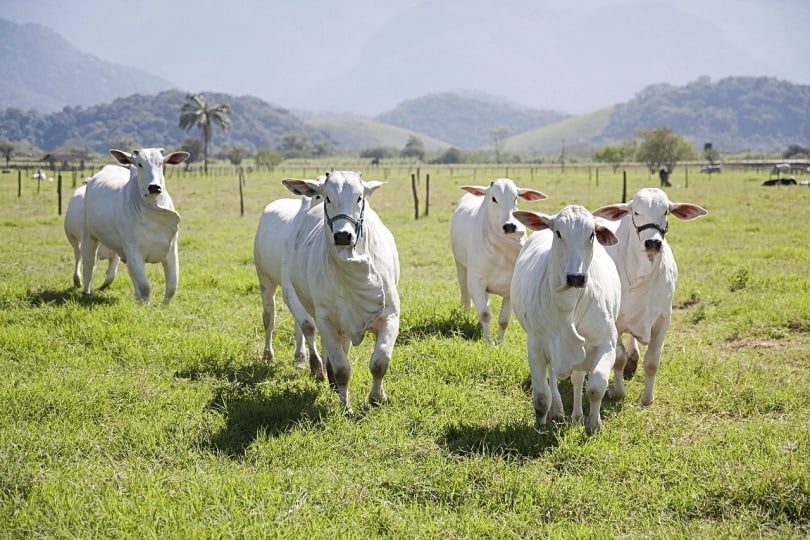Over 1,000 breeds of cattle are recognized in the world today. Many of them have similar characteristics. But with that many cows, they are bound to differ in color, pattern, and size. Domestic cows are among the most common farm animals in the world.1
When we think of cows, we might instantly imagine black and white dairy cows. They are regular sights on farms throughout the United States. Some cows are solid colors, like red, brown, and black.
Solid white cows breeds exist too, along with certain breeds that can be several colors, including solid white. Let’s take a look at a few of these.

The 9 Most Common White Cow Breeds:
1. Charolais

Originating in eastern France, Charolais cattle are mainly used for beef production today. This breed was introduced to the United States in 1934. They are among the heaviest breeds of cattle. While red and black Charolais are being bred today, these cows are usually white with pale hooves and pink noses. They tend to have horns. They’re a sturdy breed, with long, thick coats in the winter to help them withstand the weather. These cows are calm and docile, with a reputation of being easy to handle.
2. British White Cow
The British White cows are regarded as being some of the gentlest breeds in the world2. This makes them desirable to farmers who don’t want to own cattle that they are afraid to approach. Their sweet temperament even lets people get right in the pen with them. British White cows are considered a rare breed in Australia3. They are native to the United Kingdom. These cows are recognized by their white coats with black eyes, ears, noses, hooves, and tongues.
3. White Sindhi
White Sindhi cows are also called Tharparkar (Thari) cattle. Originating in Pakistan, their primary uses are working and providing milk. These medium-sized cows have long faces and horns that curve upward. They are white or light grey, with a white stripe running down their backbone. They have firm, prominent humps above their shoulders and dewlaps hanging from their throats. The ends of their tails are black.
4. Belgian Blue

Belgian Blue cows originated in Belgium and are used as beef cattle today. This breed has a natural mutation in the myostatin gene, creating more muscle development and reduced fat deposition. The result is very lean meat. These cows are heavily muscled and large. They start developing their muscles between 4–6 weeks old. In addition to being all white, they can be blue roan or black. They are known for their quiet, easy-going temperament.
5. White Galloway
Galloway cattle originated in Scotland and are either black, red, or brown. The White Galloway has an undetermined origin but is thought to get their coloring from mating with White Park cattle. This breed was considered rare during the 20th century but was granted a registration section in the herd book of the Belted Galloway Cattle Society in 1981.
These cows have bodies covered in thick, white hair. Their feet, muzzles, ears, and eyes are surrounded by dark coloring that is either red or black. These dark markings can disappear the more that the White Galloways mate with one another.
6. White Park

White Park cattle are rare, ancient horned cattle that live in Great Britain. In the United States, they are known as Ancient White Park cattle to distinguish them from the American White Park breed. Originally used as meat, milk, and working cows, the White Park cattle are primarily used for beef today. This breed has curved horns that turn upward, porcelain white coats, and black or red color points. They are similar to the British White breed.
7. American White Park
This popular beef cattle breed is different from White Park cattle despite the similar name. They are also used for milk production. This breed is thought to be descendants of purebred British White bulls that were imported to the United States from the United Kingdom. Once here, they bred with American cattle breeds to create the American White Park.
These cattle have white hair and dark black or red noses, ears, and eyes. Both males and females have large horns. They are docile, robust, and healthy cattle.
8. Chianina

Chianina cattle are among the oldest purebred cattle breeds. They are pure white and one of the largest breeds in the world, originating in the Valdichiana area in central Italy in 1500 B.C. In addition to their white coats, they may have light grey shading around their eyes. Their skin pigmentation is black, and they have black tongues, palates, noses, eye areas, and tails. Their short horns start white and turn black after the cow is 2 years old. Calves are born tan and turn white by the age of 9 months.
These cattle are used for beef production today. The Bistecca alla Fiorentina dish is made from their meat.
9. Piedmontese
The Piedmontese cattle originated in the Piedmont region of northwest Italy. They carry the same gene mutation as the Belgian Blue cattle, enabling them to grow bigger and stronger muscles. They are used today for meat and milk production. Their coats are white or wheat-colored with gray shading. They have black pigmented skin.
In addition to their long lifespans and docile nature, these cows express strong maternal instincts toward their offspring and are known for their mothering abilities.

Conclusion
White cow breeds are interesting and full of differences that may not be noticeable just by looking at their pictures. Origin, coloring, and body shape can all determine which breed of cow you’re seeing. While most white cows today are beef cattle, some are dual-purpose and provide milk too. We hope that our list helps you determine the breed of the next white cow that you see.
- Related Read: 10 Rarest Cattle Breeds in the World (With Pictures)
Featured Image Credit: Ane_Hinds, Pixabay
